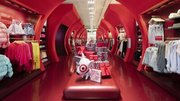Marketing
From friction to flow: How innovation frameworks can fuel gift card shopper quests for convenience
Gift cards aren’t just another SKU. They’re emotional transactions. Each one carries a moment of trust between giver, receiver and brand.

October 9, 2025 by Billy Harbinson — Director, Innovation, InComm Payments | Go Studio
Picture this: A shopper, arms full of groceries, glances toward the gift card rack.
It should be an easy stop: one card, one decision, done. But instead, the shopper stands still, scanning an overwhelming wall of lifestyle brands. Coffee shops. Streaming services. Sporting goods.
Minutes pass. Doubt creeps in. Maybe that card isn't right. Maybe another one would be better.
Finally, after a long internal debate, the shopper chooses a familiar card, trusting the recipient to decide how to use it.
Scenes like this can happen in retail environments across the country. And for brands and retailers, they represent something bigger than a missed sale. They are missed opportunities to create satisfaction, loyalty and confidence when customers are most emotionally engaged.
Merchants should strive for an effortless gift card buying experience, which means helping customers make selections before decision fatigue or time pressures cause friction in the process.
This disconnect isn't just a nuisance. It's a real factor that can affect sales and profits. And that's why the smartest brands are already rethinking their approach to gifting by leveraging unique problem-solving methods — which we in the emerging technology space call "innovation frameworks" — to design experiences that are easy, intuitive and built around real customer needs.
Because convenience isn't optional anymore. It's the baseline customers expect — and the baseline retailers must deliver.
Let's take a deeper dive into how brands and retailers can apply innovation frameworks to drive better performance and higher customer satisfaction in the gift card sector.
What the data tells us
When it comes to gift cards, the shopper's mindset is remarkably consistent: they're usually not just browsing, they're solving a problem. Whether they're looking for a last-minute thank-you, a thoughtful holiday gesture or an easy way to stay within their birthday gift budget, the appeal of gift cards lies in their simplicity.
And recent data paints a clear picture: Convenience reigns supreme.
According to InComm Payments' Gift Card Year in Review annual report, the majority of gift card shoppers — including 62% of open-loop gift card shoppers (such as Visa, Mastercard and American Express gift cards that can generally be used anywhere the payment network is accepted) and 59% of closed-loop gift card shoppers (think gift cards that are specific to a favored brand) — listed convenience as the top factor influencing their decision to buy.
"Convenience" here can be defined a few different ways:
- Product convenience: Gift cards are simple and straightforward to buy, give and use.
- Retail location convenience: Gift cards are available at a wide range of stores, which means buyers can find and purchase cards there without significantly altering their routine.
- Shopping experience convenience: Gift card displays are placed in high-traffic areas, so buyers can easily find the brands they want when they enter the store.
Gift card shoppers typically enter the process with a clear goal: Give something thoughtful, quickly and confidently. When they encounter barriers — like visual clutter, confusing categories or cumbersome checkout processes — that goal becomes harder to reach.
The importance of that clear goal to shoppers was emphasized in the InComm Payments report, which found that the vast majority (86%) of gift card shoppers said it is "very or extremely important" to know the exact brand that the person they are shopping for prefers. Merchants that do not enable shoppers to find the card they seek risk losing that customer entirely to a competitor.
For brands and retailers, this isn't just about one lost transaction. It's about eroding brand perception at a moment that should reinforce trust.
Why good intentions aren't enough
Many retailers work closely with gift card industry partners to ensure their offerings can meet shopper expectations. Displays are eye-catching, selections are broader and digital options are expanding.
But more isn't always better.
Merchants and their gift card partners closely monitor shopper preferences to ensure displays do not lead to cognitive overload. Consumers often make dozens of decisions during any shopping trip, both in store and online. Mismanaging the experience can lead to what should be a two-minute process stretching into five or ten. And every additional friction point carries cost — not just in immediate revenue, but in long-term brand perception.
Convenience isn't just about speed. It's also about removing mental load. It's about enabling a shopper to complete a task quickly, easily and confidently without second-guessing whether they made the right choice.
Innovation frameworks offer a way to deliver exactly that.
Innovation frameworks: The solution starts with the right questions
The brands and retailers leading in convenience today aren't just trying harder. They're thinking differently. And while they have an eye toward new tools and methodologies, they're not necessarily starting with flashy tech. They're starting with sharper empathy. And that means asking the right questions before rolling out a solution.
By partnering with innovation labs and strategic design teams, they're able to apply specific innovation frameworks — or structured, repeatable approaches — to solve problems, generate new ideas and design better consumer experiences.
These frameworks can help with:
- Reframing challenges from the customer's point of view.
- Identifying and prioritizing high-impact opportunities.
- Designing solutions that reduce friction and improve the end-to-end experience.
- Forecasting trends to stay agile and adaptive as consumer expectations evolve.
For example, frameworks like problem framing encourage organizations to pause and reexamine assumptions. Instead of asking, "How can we redesign our gift card rack?", a more effective question becomes, "How can we make it easier for shoppers to choose the right gift card with minimal effort?" Instead of redesigning an entire rack, the answer may be integrating new products such as multi-brand gift cards, which are a single card that can be redeemed for multiple branded gift cards. This gives recipients the flexibility of an open-loop gift card without losing the personal touch of a branded closed-loop gift card.
That kind of reframing shifts the focus from internal operations to external customer needs. It centers the design process of product displays around reducing cognitive load, not just adding polish to an outdated structure.
In addition, a tactic like user persona development can bring further precision. Gift card shoppers are not a homogenous group, but many walk into stores with specific plans. According to InComm Payments' Gift Card Year in Review, 68% of gift card shoppers plan their gift card purchases in advance. Outside of this majority, some consumers remain urgent buyers seeking the fastest path. Others are gift givers who value personal touches. Then we have those who are budget-conscious consumers seeking clear price points and no surprises.
Understanding these differences allows brands to prioritize changes that actually matter — like curated categories, better in-store signage, or simplified mobile flows.
Brands that want to compete aren't just asking what looks better on a rack. They're doing everything they can to find out what feels better to a customer, trying to complete a meaningful gesture under time pressure.
Where emerging technology fits in
While innovation frameworks start with empathetic thinking, the use of emerging technology — especially when applied thoughtfully — can amplify these improvements without creating new complexity.
One such technology is computer vision, which is quickly becoming a powerful tool in retail environments. Retailers can unobtrusively observe how shoppers interact with displays — where they pause, which sections they ignore, how long decisions take — and then use that real-world data to optimize layouts.
A real-life example of an innovation lab exploring this technology is InComm Payments' recent partnership with Kennesaw State University. As part of this joint project, researchers from KSU and InComm Payments' innovation hub, Go Studio, are designing a computer vision solution to study consumer interactions with in-store gift card aisles. Their work will focus on how shoppers behave while browsing and what emotions they express when trying to find a product. Their primary goal is to produce insights for more effective planograms to help retailers plan store layouts and product placements, ultimately reducing shopper friction for buyers.
In addition, retailers are starting to explore digital twins of their gift card racks. This technology involves creating digital replicas of physical spaces, enabling merchants to test and visualize different design elements. This technology can help explore how various innovations may work on a gift card display, from digital out-of-stock notifications to AI-powered assistance and more.
These kinds of technology-driven innovations aren't about introducing complicated solutions that will just cause more friction. They're about removing that friction, meeting customers where they are and extending their options without overwhelming them.
After all, the best technology reinforces convenience. It doesn't compete with it.
Clarity is the new competitive edge
Gift cards aren't just another SKU. They're emotional transactions. Each one carries a moment of trust between giver, receiver and brand.
Designing better gift card journeys means treating that trust with the care it deserves.
It means reducing friction, reinforcing confidence and delivering clarity in moments when it matters most.
Innovation frameworks offer the starting point. Emerging technologies offer the tools to scale what works. But the mindset shift — toward relentless simplicity and customer-first design — is what truly separates leaders from followers.
Consider whether it could be worth partnering with an innovation lab to optimize your gift card consumer experience. Because the brands and retailers willing to rethink gifting now won't just meet new expectations. They'll define them.
About Billy Harbinson
Billy Harbinson is a futurist and innovation leader with over 15 years of experience leading Innovation Labs. He has spearheaded groundbreaking digital experiences for Fortune 50 retailers, global fintech firms, higher education institutions, and startups. Billy has also served as a trusted advisor to some of the world’s largest organizations, helping them navigate and deliver transformative innovation. Outside of work, he enjoys woodworking, playing music, and exploring new places through travel.





